Click on images to enlarge
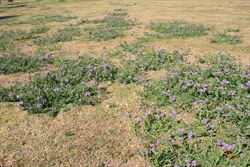
infestation (Photo: Sheldon Navie)
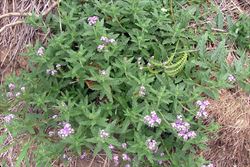
habit (Photo: Sheldon Navie)
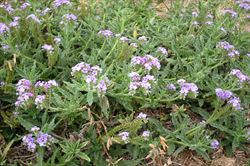
habit (Photo: Sheldon Navie)
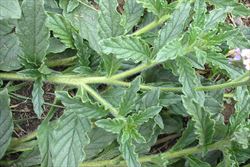
younger stems and leaves with wavy margins (Photo: Sheldon Navie)
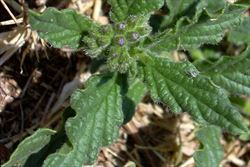
close-up of leaves and flower buds (Photo: Forest and Kim Starr, USGS)
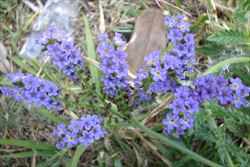
branched flower clusters (Photo: Sheldon Navie)
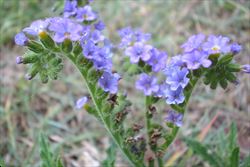
coiled branches of the flower clusters (Photo: Sheldon Navie)
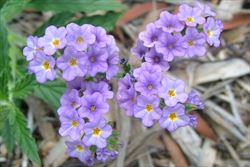
close-up of tubular flowers with yellow throats (Photo: Sheldon Navie)

immature fruit (Photo: Sheldon Navie)
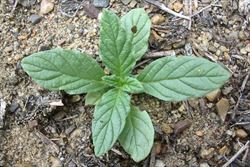
seedling (Photo: Sheldon Navie)
Scientific Name
Heliotropium amplexicaule Vahl
Synonyms
Cochranea anchusaefolia (Poir.) GurkeCochranea anchusifolia (Poir.) GurkeHeliotropium anchusaefolium Poir.Heliotropium anchusifolium Poir.Tournefortia heliotropioides Hook.
Family
Boraginaceae
Common Names
blue heliotrope, clasping heliotrope, creeping heliotrope, heliotrope, purpletop, summer heliotrope, turnsole, violet heliotrope, wild heliotrope, wild verbena
Origin
Native to South America (i.e. northern and central Argentina, southern Bolivia, Uruguay and southern Brazil).
Cultivation
Blue heliotrope (Heliotropium amplexicaule) was introduced into Australia in the late 19th century as a garden ornamental. However, it is rarely deliberately cultivated as a garden ornamental these days.
Naturalised Distribution
This species is widely naturalised throughout the eastern and south-eastern parts of Australia. It is particularly widespread and common in the coastal and sub-coastal regions of southern Queensland and northern New South Wales, and is relatively common in south-eastern South Australia and in other parts of New South Wales and Queensland. Also recorded from other parts of South Australia and sparingly naturalised in northern Victoria.
Habitat
A weed of pastures, crops and fallows, roadsides, footpaths, lawns, parks, gardens, disturbed sites, waste areas, open woodlands and grasslands in the warmer temperate, sub-tropical and semi-arid regions of Australia.
Habit
A long-lived (i.e. perennial) herbaceous plant with creeping (i.e. prostrate) branched stems that radiate outwards from a woody rootstock. It generally grows only 15-30 cm tall.
Distinguishing Features
- a low-growing herbaceous plant with numerous branched stems radiating from a central taproot.
- its alternately arranged leaves are elongated, hairy, and have wavy margins.
- its distinctive coiled flower clusters have numerous small (5-8 mm long) tubular flowers.
- these flowers are blue or purplish in colour with yellow throats and are arranged in two rows along one side of the flowering stem.
- the flowering stems elongate and straighten as the small, dark brown, warty 'seeds' begin to mature.
Seedling
The two seed leaves (i.e. cotyledons) are egg-shaped in outline (i.e. ovate) and borne on relatively long stalks (i.. petioles). They have rounded tips (i.e. obtuse apices) and are about 6mm long by 3 mm wide. The first ture leaves are oval (i.e. elliptic) to egg-shaped in outline (i.e. ovate) with prominent indented veins. They are sparsely and softly hairy (i.. sparsely pubescent) and borne on short stalks (i.e. petioles).
Stems and Leaves
The branching stems are green, very hairy (i.e. pubescent), and grow up to 1 m long.
The alternately arranged leaves do not have distinct stalks (i.e. they are sessile or sub-sessile), and the bases of some leaves are stem-clasping (i.e. ). These leaves (20-80 mm long and 3-20 mm wide) are hairy (i.e. pubescent) and elongated in shape (i.e. oblanceolate to lanceolate). They have prominent veins, wavy (i.e. undulate) margins and pointed or rounded tips (i.e. acute or obtuse apices). The upper leaf surfaces are dull green in colour, while the lower surfaces are paler green.
Flowers and Fruit
The small tubular flowers (4-6 mm long and 3-6 mm across) are arranged in two rows along one side of a coiled flower spike (i.e. boragoid inflorescence). However, these flower spikes straighten and elongate as the fruit mature. The flowers are purple, lilac, blue or pinkish in colour and have a distinctive yellowish throat. They are made up of five petals that are fused into a tube (i.e. corolla tube) for most of their length, and are surrounded by five green hairy sepals (about 3.5 mm long). Each flower also has five small stamens inside the flower tube and a four-lobed ovary topped with a very short style and broad hairy stigma. Flowering occurs throughout most of the year, but is most apparent from late spring through until early autumn.
The fruit consists of two small 'seeds' (i.e. nutlets or mericarps) which separate from each other at maturity. The 'seeds' are rounded (i.e. sub-globular) in shape and have a wrinkled (i.e. rugose) or warty (i.e. tuberculate) surface. They are dark brown or black in colour and hairless (i.e. glabrous).
Reproduction and Dispersal
This plant reproduces mostly by seed, but can also produce shoots from its roots and establish from root fragments.
The seeds may dispersed by animals, water, vehicles, and in contaminated soil and agricultural produce (e.g. fodder). Root fragments can be broken off and spread about during cultivation or road maintenance, and may also be dispersed longer distances in contaminated soil.
Environmental Impact
Blue heliotrope (Heliotropium amplexicaule) is regarded as an environmental weed in New South Wales, Queensland and South Australia. Though it is mainly seen as a weed of roadsides, disturbed sites and pastures, it is also listed as a priority environmental weed in three Natural Resource Management regions. It displaces native species, particularly in overgrazed or otherwise disturbed areas, and prefers sandy soils.
This species is currently of most concern in the inland regions of New South Wales, and is conservatively estimated to occupy more than 110,000 hectares in this state. Major infestations occur in areas receiving more than 500 mm of rainfall per year, although it is also established in low rainfall areas in the western districts of the state. Blue heliotrope (Heliotropium amplexicaule) is listed as an environmental weed in some inland areas of this state (e.g. in the Hawkesbury region and the Namoi catchment) and has invaded conservation areas, particularly in the northern parts of the state.
For example, in the Warrumbungle National Park, in Northern Plains region, blue heliotrope (Heliotropium amplexicaule) is dominant in the Central Valley section of the park. Populations also occur on grazing areas adjacent to the Pilliga Nature Reserve in this region. This species out-competes more palatable species grazed by native herbivores, and its dominance in certain areas is linked to excessive grazing pressure by heavy concentrations of eastern grey kangaroos (Macropus giganteus). Blue heliotrope (Heliotropium amplexicaule) also occurs in the Merriwa River and Death Adder areas of the Goulburn River National Park in the Mudgee region.
This exotic species also out-competes native ground species in woodland vegetation of the Cumberland Plains region, west of Sydney, and is a weed in sites occupied by the endangered herb Zieria obcordata, near Wellington and Bathurst in inland southern New South Wales.
Blue heliotrope (Heliotropium amplexicaule) is also considered to be a threat to rangeland biodiversity in Queensland and has invaded conservation areas in South Australia (e.g. Ferguson Conservation Park, Morialta Conservation Park and Onkaparinga River Recreation Park).
Other Impacts
In northern New South Wales and southern Queensland, blue heliotrope (Heliotropium amplexicaule) has undergone rapid recent spread in both cultivated pastures and crops. It is considered to be a serious weed in pastures in these areas, because it competes with desirable summer pasture species and significantly reduces pasture productivity. It is also poisonous to livestock, especially young cattle.
This species is as a major weed of crops in the Darling Downs and Burnett regions, in south-eastern Queensland, and northern New South Wales. It is also a less important weed of crops in other parts of Queensland (i.e. on the Western Downs, in the Moreton district, and in central Queensland).
Legislation
This species is declared under legislation in the following states and territories:
- New South Wales: Class 4 - a locally controlled weed. The growth and spread of this species must be controlled according to the measures specified in a management plan published by the local control authority and the plant may not be sold, propagated or knowingly distributed (in numerous local authority areas). See the New South Wales Department of Primary Industries Noxious Weeds List at http://www.dpi.nsw.gov.au for more detailed information on which local areas are covered in these declarations.
- Western Australia: Prohibited - on the prohibited species list and not permitted entry into the state.
Management
For information on the management of this species see the following resources:
- the New South Wales Department of Primary Industries Agfact on this species, which is available online at http://www.dpi.nsw.gov.au.
- the Hunter and Central Coast Regional Environmental Management Strategy weed information sheet on this species, which is available online at http://www.hccrems.com.au.
Similar Species
Blue heliotrope (Heliotropium amplexicaule) is similar to common heliotrope (Heliotropium europaeum), Indian heliotrope (Heliotropium indicum) and smooth heliotrope (Heliotropium curassavicum). They can be istinguished by the following differences:
- blue heliotrope (Heliotropium amplexicaule) is a creeping (i.e. prostrate or decumbent) stiffly hairy (i.e. pubescent) plant with much-branched stems and relatively few basal leaves that are elongated in shape. Its relatively small (4-5 mm long) blue, pink or purplish tubular flowers have yellowish throats.
- common heliotrope (Heliotropium europaeum) is an upright (i.e. erect) or semi-upright (i.e. decumbent or ascending) plant with much-branched stems and relatively few basal leaves that are oval in shape (i.e. elliptic). Its relatively small (2-3 mm long) whitish coloured tubular flowers have yellowish throats.
- Indian heliotrope (Heliotropium indicum) is an upright (i.e. erect) plant with mostly unbranched stems and basal leaves that are egg-shaped in outline (i.e. ovate). Its relatively small (4-5 mm long) purplish coloured tubular flowers fade to dull white and have yellowish throats.
- smooth heliotrope (Heliotropium curassavicum) is a creeping (i.e. prostrate) hairless (i.e. glabrous) plant with much-branched stems and basal leaves that are oblong or elongated in shape. Its very small (1.5-2 mm long) whitish coloured tubular flowers have yellowish or reddish throats.
It is also relatively similar to the yellow burrweeds (Amsinckia spp.) and some of the low-growing verbenas (Verbena spp.), as they also have similar tubular flowers. However, the yellow burrweeds (Amsinckia spp.) are upright (i.e. erect) or semi-upright (i.e. ascending) plants with pale yellow to orange tubular flowers. The verbenas (Verbena spp.) do not have coiled flower clusters and their leaves usually have toothed or highly divided margins.

